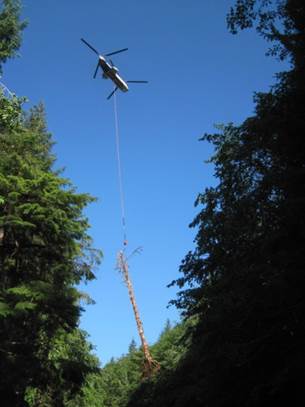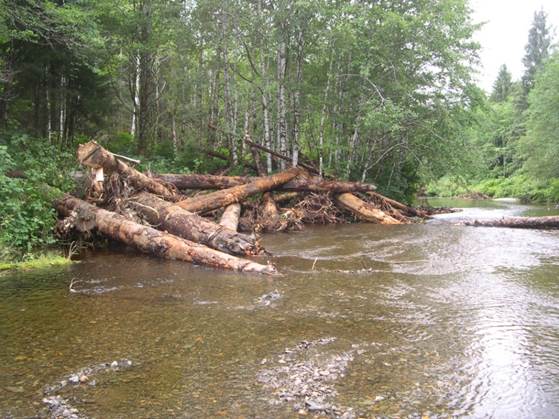|
Tongass Twelvemile Watershed stream restoration successfully completed KETCHIKAN, Alaska–In late July 2013, the US Forest Service
and partners successfully completed stream restoration efforts in the Twelvemile Creek watershed on Prince of Wales Island. This wraps up a major watershed restoration effort that started with planning and design work in 2009, included wildlife habitat and
streamside vegetation improvements, fish crossing and road condition improvements, and concluded with major in-stream channel work in 2012 and 2013. As part of the National Forest Foundation’s (NFF)
Treasured Landscapes, Unforgettable Experiences conservation campaign, this project exemplifies how myriad partners and communities can work together to achieve significant restoration results. Primary partners included the US Forest Service, the NFF,
and The Nature Conservancy (TNC). The project was funded by grants from these partners, the National Oceanic and Atmospheric Administration’s Alaska Sustainable Salmon Fund, the National Fish and Wildlife Foundation, and the local communities through Title
II funds for ecological restoration. Species benefiting from these efforts include: coho, pink and chum salmon, steelhead trout, resident and anadramous cutthroat trout and Dolly Varden, Sitka black-tailed deer, wolf and black bear among others.
Logging practices that took place during the era when there was little protection for stream habitat and adjacent riparian vegetation left Twelvemile Creek Watershed in an impaired state.
These practices included clear-cutting riparian corridors (areas adjacent to streams), removing large wood from the stream channels, extracting gravel from the stream to build roads, and yarding logs over the streambanks and through riparian vegetation. Twelvemile
was one of the watersheds most heavily impacted by past logging on the Tongass National Forest. About 50% of the 19.6 square mile watershed was logged beginning in the early 1960s, including 90% of the riparian forest along streams that salmon use for spawning
and rearing. Impacts of these activities included erosion from road building and roads, introduction of invasive plants, and impaired fish and wildlife habitat.
Old growth trees along the banks of salmon streams, such as Twelvemile Creek, are critical to the function and stability of the channel. When these large trees die or blow over into the
creek, they provide important wood structure that slow down and spread out water during high flows. This wood is critical to stream function and productive salmon habitat. It interacts with the stream channel and stabilizes spawning gravels, provides shelter
for migrating adult salmon, resident adult, and juvenile fish. Old growth trees were cut right up to the bank in the Twelvemile Creek watershed. In addition, the majority of existing large wood in the stream prior to logging had decayed and flushed out of
the creek. With very few big trees left along the banks to replace the lost wood, the Forest Service and partners prioritized Twelvemile Creek watershed as an area that would benefit from restoration treatments that have previously been used to successfully
improve habitat in watersheds including Harris River, Staney Creek, Sal Creek, and Snipe Creek. In 2010, Secretary of Agriculture Tom Vilsack described his
Vision for the Forest Service policy stating “restoring watershed and forest health would be the primary management objective of the Forest Service.” Due to the degraded state of the stream, the US Forest Service and partners moved to address the impaired
conditions. As Greg Killinger, the Fish, Watershed, and Soils Program Manager on the Tongass National Forest, explains, “the Twelvemile restoration project is like a band-aid for the next forty to fifty years or more, holding the ecosystem together and keeping
it productive until the young trees along Twelvemile Creek grow large enough to start regulating the system again.”
To maintain and improve stream function and habitat diversity, more than 600 trees, some with root wads still attached, were harvested from nearby areas (away from the recovering streamside
forests) and flown by helicopter to staging sites along the stream. The use of a helicopter to transport the trees greatly minimized impacts to the recovering riparian forests. Most of the trees were “young growth” in order to preserve the remaining intact
old growth in the watershed. From the staging areas, operators from Southeast Road Builders, Inc. (2012 work) and S&S General Contractors, Inc. (2013 work) used tracked excavators to place the wood and build logjam structures in the stream. Craig District
Ranger, Matthew Anderson, visited the scene during implementation and was impressed by the collaborative effort on the ground with The Nature Conservancy representative Norman Cohen, Forest Service hydrologist and fisheries biologist putting their minds together
with the local contractors operating equipment and constructing logjams. “It was apparent during the 2013 hot, dry weather, when stream flows were critically low, that migrating salmon were utilizing pools developed with large wood additions during the 2012
restoration efforts,” said Anderson. “They were taking refuge there, and appeared to be crowding into these pools to survive the dry spell until flows increased and they could continue to migrate and spawn.”
The Tongass National Forest is truly a salmon stronghold, home to one of the most productive and sustainable salmon fisheries in the world. The Tongass is one of 155 national forests in
the US, but it produces 70% of all salmon that spawn and rear on national forest lands. “When we invest in systems like Twelvemile that are at risk but still very productive, we make an investment that pays off: healthy salmon runs are economically, ecologically,
and culturally important to Southeast Alaska,” said Cohen. The work accomplished upgraded the rating of Twelvemile Creek watershed from a ‘Functional at Risk’ to a ‘Properly Functioning’ classification. The work benefits commercial, sport and
subsistence fishermen as it provides insurance that the function of these salmon spawning grounds and rearing areas will persist. Improved wildlife habitat and available forage will benefit sport and subsistence hunters. Completion of these projects also contributed
to local communities and economies since multiple contracts were required over several years to complete the work. Now that restoration work is complete, the Forest Service and the NFF are implementing extensive monitoring with local partners for the next
several years. This monitoring will help to inform future habitat restoration projects.
For more information, contact Sarah Brandy, Recreation, Fisheries Biologist, Craig and Thorne Bay Ranger Districts. Sarah may be reached by phone at 907-826-1634 or e-mail at sbrandy@xxxxxxxxx.
-end- This electronic message contains information generated by the USDA solely for the intended recipients. Any unauthorized interception of this message or the use or disclosure of the information it contains may violate the law and subject the violator to civil or criminal penalties. If you believe you have received this message in error, please notify the sender and delete the email immediately. |


